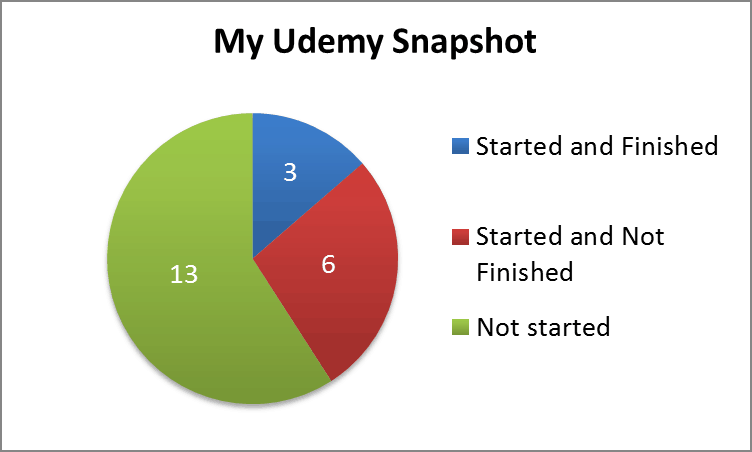Nir’s Note: This guest post is written by Ali Rushdan Tariq. Ali writes about design, entrepreneurship, creativity and innovation on his blog, The Innovator’s Odyssey.
As I clicked the big green “Take This Course” button, I became acutely aware of an uneasy feeling. This would be the 22nd course I’d have signed up for on Udemy.com, one of the world’s leading platforms for teaching and learning classes online. I had become a binge-learner.
Or had I? After scanning my enrolled course list, I gathered the following stats:
And so the uneasy feelings inside bubbled to the surface. With 13 courses left virtually untouched since enrolling (the price ranging from free to $30 for each of them) I naturally started deriding myself. I thought I was a non-finisher, bad at commitments, and lacked focus. Perhaps even a compulsive buyer, financially carefree, or worse yet, a wanna-be learner. Perhaps it was some combination of the above?
In other words, I thought something was wrong with me. Then I remembered the teaching of designer Donald A. Norman in his most popular work, The Design of Everyday Things. In it, he extolls that people’s ineptitude in using objects stems not from their own incompetence but from poor design. He says, “… people feel guilt when they are unable to use simple things, guilt that should not be theirs but rather the designers and manufacturers of the object.”
This gave me a little respite and I began to wonder: Is Udemy well-designed, because of its ability to convince me to continuously enroll for new courses, or is it poorly-designed, because of its inability to help me follow-through with my learning objectives?
In the rest of this article, I step through Nir Eyal’s hook framework to show how some specific design decisions lead to Udemy’s seemingly diametric user experiences.
Triggers
Udemy operates in the education sector and thus, the triggers that drive students to it are not that difficult to understand. The external triggers are quite explicit. They come largely in two types: 1) email triggers and 2) on-site triggers.
1) Email Triggers
Once a user signs up as a member of the site, the company periodically sends promotional emails to engage them. For me, the most compelling emails advertise course sales. Interestingly, these emails generally tend to be sent by the teachers of the courses rather than by Udemy staff. This tends to make the emails targeted and relevant for students.
2) On-site Triggers:
Udemy’s course catalog is an aesthetically pleasing display of courses with compelling titles (e.g. “7 Comedy Habits to Becoming a Better Speaker”) laid out in aisles upon aisles of course offerings. The easy-on-the-eyes look and feel of the course listings coupled with the announcements of deep discounts makes browsing Udemy similar to grocery shopping — you enter looking to buy milk, then leave with some frozen fruits, a bag of potato chips, a jar of pickles and some condiments.
Over time, if users follow through on these external triggers enough, Udemy will be the first thing they think of when they want to learn a new skill. On a personal note, I have stepped through the above external triggers so frequently that the next time I find myself wanting to learn mobile app development, I will likely make it a point to search for a course on Udemy first.
Action
Most students search Udemy’s course offerings when they are motivated to learn a particular skill, from Excel mastery to learning how to sing. This desire may come from an innate curiosity or perhaps when a job prompts the user to strengthen or complement their existing skills.
But motivation alone is not sufficient; in order for users to take action, they must also have the ability to do so. Similar to Amazon’s one-click shopping, Udemy makes enrollment in courses as easy as possible — first, popping-up a purchase window and second a purchase order. Your credit card details are kept on file, saving you time and effort on every purchase.
When the ability to enroll is this easy, deep discounts boost motivation. When the right triggers are present, BJ Fogg’s Behavior Model predicts that students will follow through with the intended behavior.
Rewards
By virtue of the constantly changing roster of courses on a wide range of topics, Udemy’s offering has inherent variability. Depending on what courses you are taking, you may learn how to code an app in Javascript and then learn how to get better sleep. This variability keeps things interesting and enticing.
Udemy leverages Reward of the Hunt – that is to say, our craving for amassing possessions. This is manifested in the site’s two main lists that students use most often — the Learning list and the Wishlist. The former displays courses the student has enrolled in, while the latter displays courses that the user wants to track for future reference. I found myself adding more and more courses to my Wishlist, even if some of them only partially interest me. And yes, a number of these courses from my Wishlist, eventually ended up in my Learning list.
Investment
The final major design decision Udemy employs to keep users habitually coming back, is displaying how much they have invested in their learning. The site offers a real-time progress bar to show students what percentage of a course they have completed. The way courses automatically move to subsequent lectures after completing a section makes progress appear seamless and makes students more likely to return.
Possible Improvements
The product designers at Udemy deserve credit for implementing decisions that lead to higher user enrollments. The Hook framework demonstrates a number of key areas that Udemy has benefitted from in its rapid growth to 2 million members. Specifically they have made it as painless as possible to discover and sign-up for courses while providing relevant and timely triggers for users to act on their motivations to purchase.
But if the company’s goal is to help people learn, it should more deliberately invest in enabling users to not only sign up, but also to see them through to the end. The danger of not doing so will be that students like me who find themselves overwhelmed by their course-loads suffer a kind of course fatigue and avoid coming to the site altogether. Here are some ways I suggest that Udemy’s can address their completion challenges:
1) Invest in Rewards of the Tribe
Currently, the social aspect of Udemy’s offering is very limited. In my six months on the site, I have yet to collaborate with other students and I am not even sure how I would do so. Like going to the gym with workout buddies, a supportive community would provide camaraderie to encourage members to stick to their lesson plans and see themselves through to completion. While each course does have a discussion section, the site does not provide many cues or incentives for students to collaborate.
2) Implement course-based triggers
In its current design, once users sign up for a course, they are only contacted when a teacher has a message to broadcast. Udemy should consider sending reminder messages or emails to prompt students to revisit courses they have not completed. A harsher and more tenuous measure might be to set caps on students’ course-loads, much like at traditional schools. A hard limit of say five courses at a time will act as a trigger for students to buckle down and complete their enrolled classes. While this might hamper sales initially, it may very well lead to higher course-completion rates in the long-term and thus higher customer satisfaction.
I believe that as long as Udemy helps its customers achieve their learning goals (as opposed to simply amassing more course sales) it has a bright future.
What other ways do you think Udemy and other online courses could increase completion rates?
Note: This guest post is written by Ali Rushdan Tariq, who writes at The Innovator’s Odyssey.
Related Articles
- Schedule Maker: a Google Sheet to Plan Your Week
- Cancel the New York Times? Good Luck Battling “Dark Patterns”
- How to Start a Career in Behavioral Design
- A Free Course on User Behavior
- User Investment: Make Your Users Do the Work
- Variable Rewards: Want To Hook Users? Drive Them Crazy
- The Hooked Model: How to Manufacture Desire in 4 Steps

